In yesterday’s round five of the Santa Cruz Cup, Jeff Mallett and I played a very exciting game. After a death-defying opening in which Jeff seemed to get a huge advantage, I gradually managed to improve my position, and shortly after the time control I had an easily winning rook-and-pawn endgame. But in a key position (which I’ll show you below) I hallucinated that his rook could move like a knight and take one of my pawns! I do know how a rook moves, of course, but what really happened was that I forgot which rank it was on. As a result I played an inferior move, and we ended up drawing.
Looking back now it’s hard to believe I fell into this “optical illusion,” but my analysis was 14 plies (7 moves) deep, plus I had been playing almost six hours, and I had a cold, and I hadn’t eaten. All of these things contribute to seeing things that aren’t there.
There were many reasons why I was not terribly upset about throwing away this game. First and foremost, my situation in the tournament only required a draw. The format of the tournament is a seven-game round robin, followed by a quad among the top four finishers. A draw was all I needed to clinch a berth in the “playoffs.” A second reason I couldn’t be too upset was that my position was so bad earlier that I would have been very happy with a draw. And finally, it was karma. In this tournament I have already won two endgames that should have been draws, so I was “due” to give half a point back. Consider it an offering to the chess gods.
Okay, enough preamble! I’m sure you want to see the game, and there are some really great positions to show you.
Jeff Mallett – Dana Mackenzie
1. d4 Nf6 2. c4 Nc6 3. Nf3 e6 4. Bg5 Bb4+ 5. Nbd2 h6 6. Bxf6 Qxf6 7. a3 Be7?! 8. e3 Qg6 9. d5! Nd8 10. Ne5 Qf6 11. f4! d6! 12. Ne4 Qf5 13. Bd3 de
Today’s first quiz: Should White take the queen for three pieces with 14. Nd6+ Bxd6 15. Bxf5 ef, or does he have something better?
A few moves later we got to the following position:
Today’s second quiz: White to move. Is there anything better for him than the routine retreat 18. Ng3?
Jeff did play 18. Ng3 and continued to have a nice lead in space and development, but it gradually evaporated, and as the endgame approached his d5 pawn began to turn into a significant weakness. We now come to Black’s 41st move (one move after the time control), which was my one really nice move of the game.
Today’s third quiz: Black to play and get a winning endgame.
Finally, we come to the position where it all came undone. It’s Black to play his 52nd move.
First of all, as Ilan Benjamin pointed out, 52. … Rc7 is obviously winning. This should be kid stuff. It’s two pawns against one, and what should happen is that Black gives up his rook for White’s pawn and then forces White to give up his rook for one of Black’s pawns, leaving the other one (probably the a-pawn) to queen. Best play, according to my computer, is 52. … Rc7 53. Ra1 b4 54. Kf6 b3 55. g5 b2 56. Rb1 Rc2! (It does get a little tricky after all. 56. … Rb7 only draws.) 57. g6 Rf2+! (gaining a key tempo) 58. Ke7 Rg2 59. Kf7 Kd4 60. g7 Kc3 and Black wins.
But I never even analyzed this variation! For some reason I was completely hypnotized by the discovered check possibilities. In the position above I spent about ten minutes looking at 52. … Kc4+, which also wins! My analysis went 53. Kf6 Rc7 54. g5 b4 55. g6 (the computer suggests 55. Ra1! with the idea of a x-ray check on the c-file, but Black is still winning after 55. … Kd3) 55. … b3 56. g7 Rxg7 57. Kxg7 b2! and Black wins! This lovely position deserves a diagram:
White’s rook has no way to stop the pawn from queening, as all the key square b6, a1, and c1 are defended. The best White can do is go into a rook-versus-queen endgame with 58. Rxa7 b1Q. This would have been very interesting practice for me, as I have never played this endgame in a tournament!
Alas, it didn’t happen, because as I was double-checking it suddenly struck me that White could play 58. Rc6+ Kb3 59. Rxa7!?!?! Of course, this would save the draw… if only it were a legal move! In my deep analysis I had somehow “shifted” White’s rook to c7, which made all the difference. What a disappointment it was after the game to realize that I had calculated the win correctly and then not played it!
Because I was under the impression that 52. … Kc4+ only draws, in position (*) I played 52. … Ke4+??, after which it’s a dead simple draw. Jeff played 53. Kf6! Kf4 54. Ra7 Kxg4 55. Ke6 Kf4 56. Kd6 Re5 57. Rb7 Ke4 58. Kc6 and Black’s king is just one tempo too slow to defend the g-pawn. Of course I should have been able to figure this out, but fatigue and chess psychology got to me. I’ll admit that it crossed my mind, when I played 52. … Ke4+?, “At least in this line I have no losing chances.”
Standings after round five: Mackenzie 4.5, Benjamin 4.5, Perea 3, Burkhard 2, Mallett 2, Tan 2, Seehart 1, Parker 1. (Seehart didn’t show up for his game with Tan, so I’m assuming that will be a forfeit.)
Answers to quiz questions:
- Jeff played the very nice move 14. Ng3!, which I was not expecting. The clever point is that Black must give back the piece in order to rescue his queen. If 14. … Qf6 (box) 15. Nh5! Qh4+ 16. g3 Qh3? 17. Bf1! Qf5 18. Nxg7+ wins the queen. So instead I played 15. … Bb4+ 16. ab Qe7 17. O-O g6!?, which gets us to quiz question number two.
- Here Jeff played 18. Ng3? rather quickly, and missed his chance for 18. Ng7+! Kf8. Wait, isn’t the knight trapped? Yes, but he can destroy Black’s defenses with 19. Nxe6+!! fe? 20. fe+ Kg8 21. Rf6, and it’s lights out for Black. Black can keep on struggling with 19. … Nxe6 instead, but White has a great advantage after 20. de Bxe6 21. fe Kg7 22. Qf3, threatening both Qxb7 and Qf6+. This is clearly better than what Jeff played, although after 18. Ng3 White does retain some advantage.
- My only nice move of the game was 41. … g5! which fixes a third pawn weakness (d5, c3, and g4). The game continued 42. fg fg+! 43. hg hg 44. Kg3 Re4, and Black brings his rook around and wins the d5 pawn, after which the endgame should have been won.
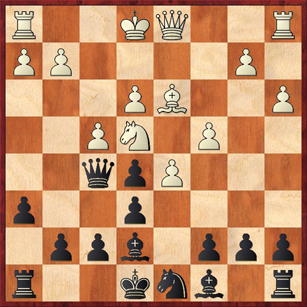
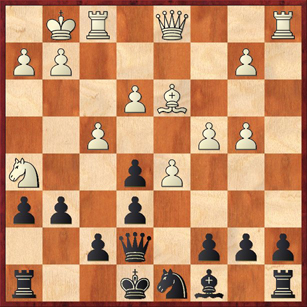
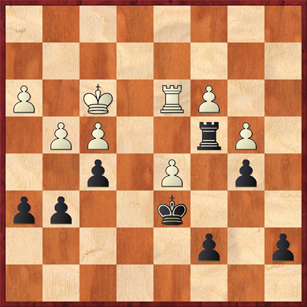
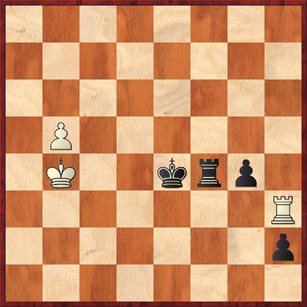
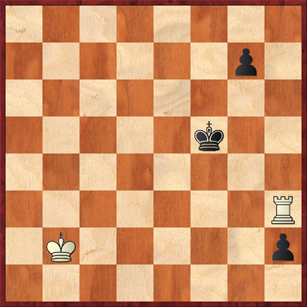



{ 3 comments… read them below or add one }
Very nice game, with intriguing analysis! Enjoyed. That halluzination-thing happens sometimes, as funny (or horrid) as it can be. I think I have to bookmark your blog ; )
Thanks for your comment, ChessWanderer, and I hope you come back often!
I would never have considered 18. Ng7+ followed by 19 Nxe6+ seeing that the e6 pawn is defended by no less than 4 pieces. However, this sequence seems to give a winning advantage to white. So then: who was the one that got away? 🙂
{ 1 trackback }